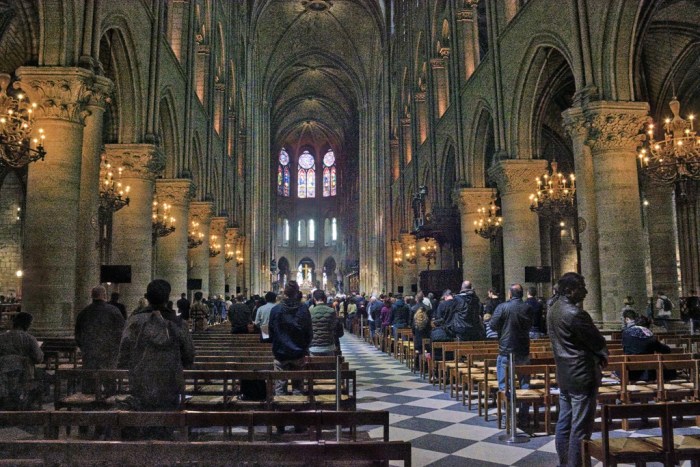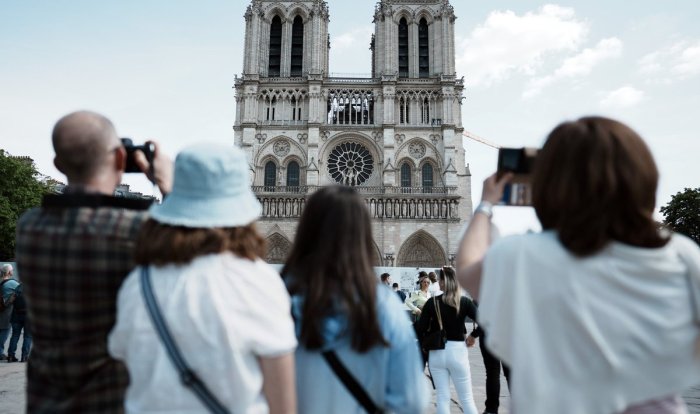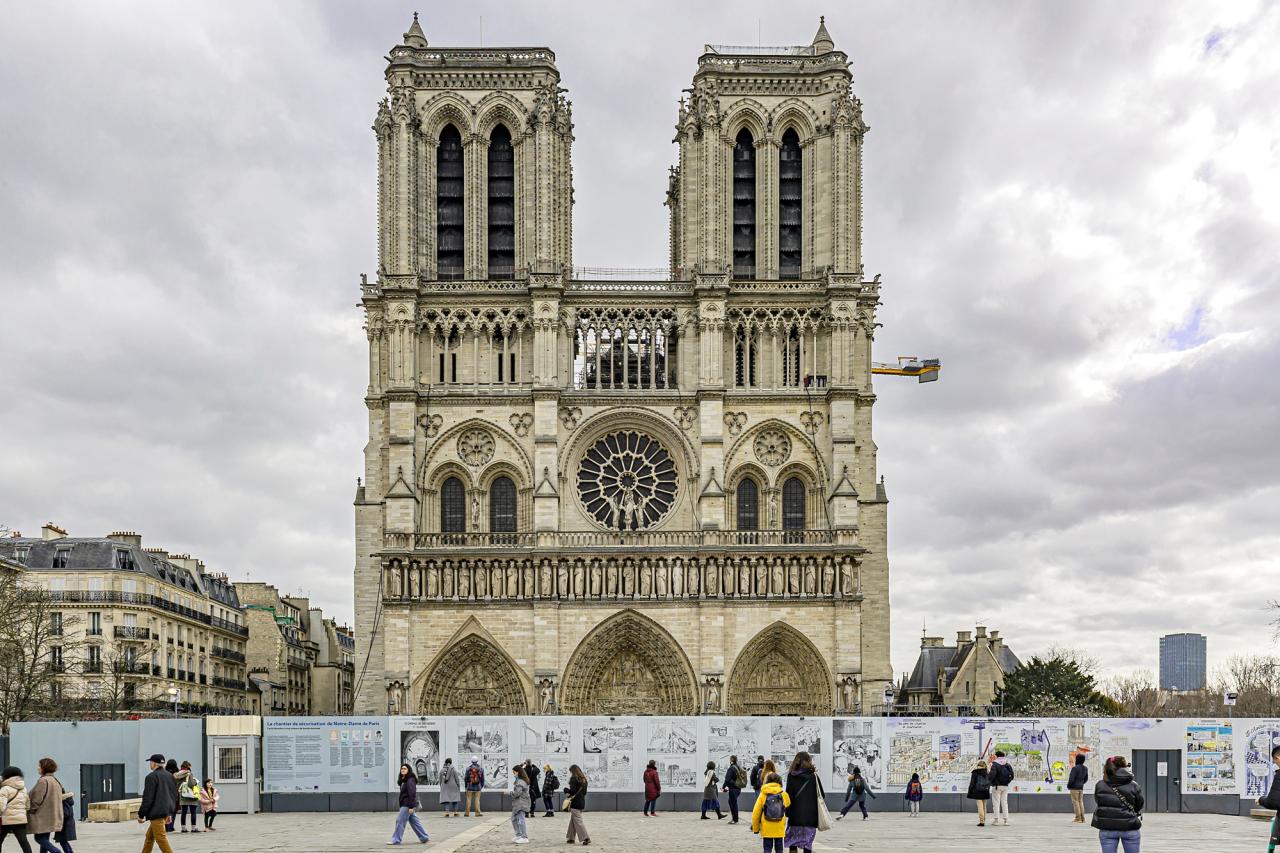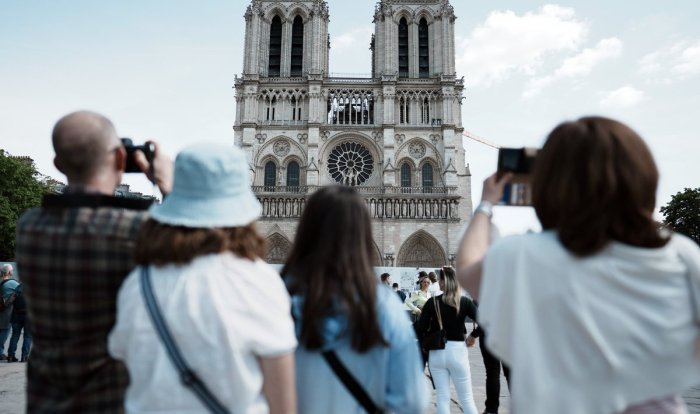Guide to Notre Dame Paris: Embark on a captivating journey through the heart of Paris, exploring the iconic Notre Dame Cathedral. This comprehensive guide unveils the history, architecture, and cultural significance of this magnificent landmark. From its intricate stained glass windows to its remarkable restoration project, you’ll gain a deeper appreciation for this architectural masterpiece and discover practical tips for your visit.
This guide provides detailed information about the cathedral’s opening hours, ticket prices, and accessibility options. Discover fascinating facts about the Île de la Cité and the surrounding area. Learn about the restoration project and the rich history that surrounds this iconic Parisian landmark. Explore different tour options and find the perfect fit for your interests. We’ve also included a wealth of information about the cathedral’s interior, exterior, and the historical context.
Introduction to Notre Dame Cathedral
Notre Dame Cathedral, a towering symbol of French Gothic architecture, stands as a testament to the artistic and religious fervor of the Middle Ages. Its intricate beauty and profound history have captivated generations, drawing millions of visitors each year. This guide delves into the rich tapestry of Notre Dame, exploring its architectural marvels, cultural significance, and the ongoing restoration efforts that aim to preserve this iconic landmark for future generations.The cathedral’s grandeur and intricate design are not merely aesthetic flourishes but rather meticulously crafted expressions of medieval artistry and engineering.
Its story encompasses centuries of devotion, artistic innovation, and, sadly, devastating loss. Understanding this history, both in its triumphs and tragedies, is key to appreciating the cathedral’s enduring legacy.
Historical Significance
Notre Dame Cathedral’s construction began in the late 12th century, a period of significant religious and social upheaval in France. It served as a central place of worship, housing relics, and hosting important religious ceremonies. The cathedral’s completion spanned over a century, reflecting the sustained commitment and dedication of generations. Its design evolved through the architectural styles of the period, evolving from the early Gothic to later additions.
Architectural Style and Features
Notre Dame is a prime example of French Gothic architecture. Characterized by soaring arches, pointed vaults, ribbed vaults, and intricate stained-glass windows, the cathedral embodies the innovative structural and artistic techniques of the era. The building’s iconic facade, with its gargoyles, sculptures, and rose windows, showcases the meticulous craftsmanship of the time. These features not only served a practical function, but also provided artistic expression of religious themes.
Cultural and Religious Importance
The cathedral’s cultural and religious importance is immeasurable. It has served as a focal point for countless religious ceremonies, celebrations, and artistic events. For centuries, it held a special place in the hearts and minds of the French people, symbolizing their national identity and religious devotion. Its iconic status as a significant historical landmark has brought immense cultural influence, transcending religious boundaries.
Restoration Project Overview
The devastating fire in 2019 caused significant damage to Notre Dame, including the collapse of the roof and significant damage to the structure. The subsequent restoration project is a monumental undertaking, aiming to repair the structural damage, recreate the lost architectural elements, and preserve the cathedral for future generations. This project has mobilized international efforts and brought together experts from various fields to carefully recreate the intricate details and artistry of the original structure.
The project’s successful completion is crucial to preserving this irreplaceable historical treasure.
My guide to Notre Dame in Paris is all about the iconic architecture and history. It’s a great way to learn about the cathedral’s past, but if you’re looking for stunning natural beauty, you should definitely check out hiking trails in Japan’s Gifu and Ishikawa regions. japan gifu ishikawa hiking offers incredible scenery and challenging climbs, perfect for nature lovers.
Still, a visit to Notre Dame is an experience that should be on every traveler’s list.
Practical Information for Visitors
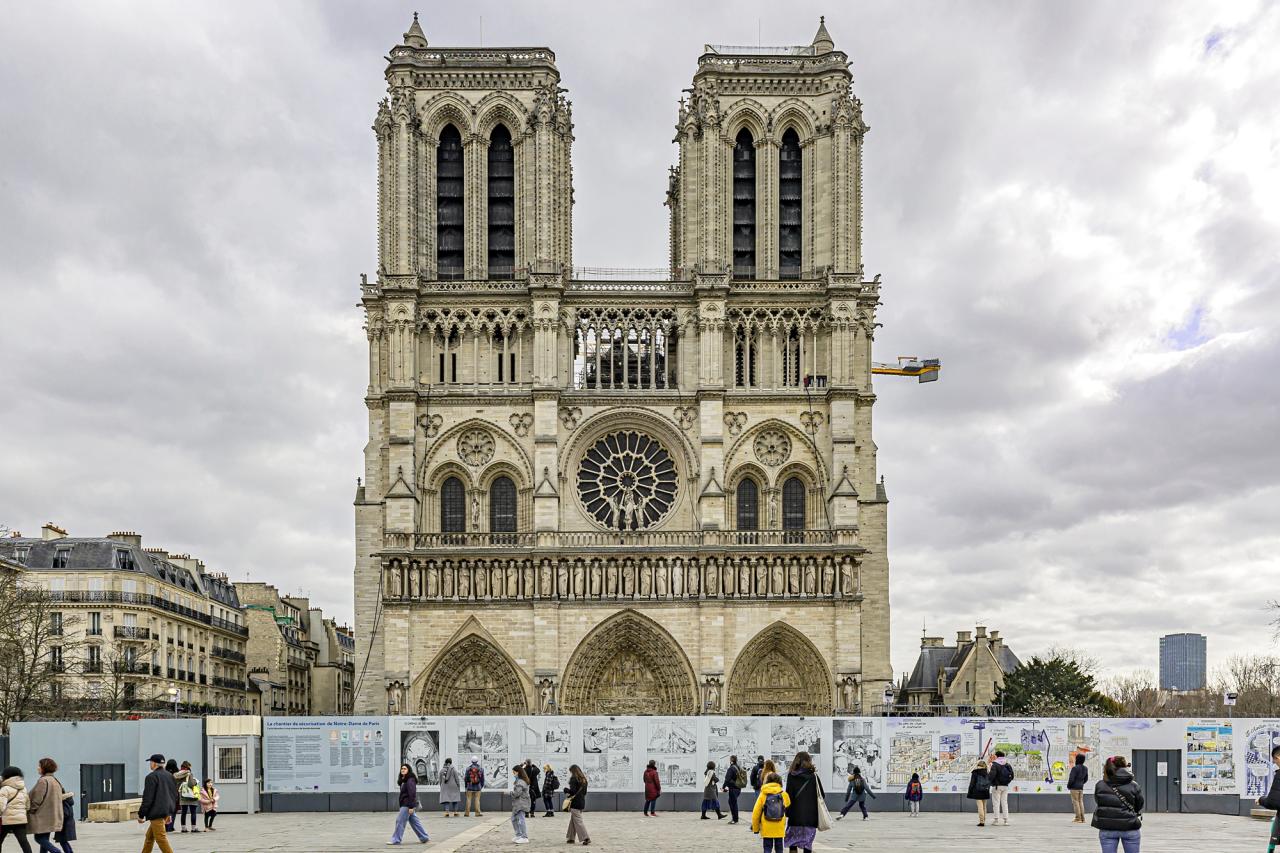
Visiting Notre Dame Cathedral offers a unique experience, but understanding the practical aspects is crucial for a smooth and enjoyable visit. Knowing the opening hours, ticket prices, accessibility options, and transportation details can save you time and frustration. This section provides vital information to help you plan your trip.
Opening Hours and Ticket Prices
Notre Dame Cathedral’s opening hours vary throughout the year. It’s essential to check the official website for the most up-to-date schedule. General admission times are typically available during daylight hours, with extended hours potentially offered for special events. Ticket prices are dependent on the time of year and the specific tour or experience chosen. Pre-booking tickets online is highly recommended to avoid queues and ensure entry.
Accessibility Options
The cathedral strives to be accessible to all visitors. Information on accessible entrances, ramps, and elevators is available on the official website. For visitors with specific needs, advance notification is often beneficial to guarantee the most appropriate assistance. Staff members are trained to assist visitors with mobility impairments and provide information in multiple languages.
Available Tours and Guided Experiences
Notre Dame offers a range of tours and guided experiences, catering to different interests and time constraints. These tours provide insights into the cathedral’s history, architecture, and artistry, often led by knowledgeable guides. Guided tours are a valuable way to enhance your understanding of the cathedral’s significance. There are typically different options available, each with varying durations and focuses.
Parking Options and Public Transportation
Parking near Notre Dame can be challenging and expensive. Consider using public transportation, such as the metro, to reach the cathedral. The closest metro stations provide convenient access and minimize parking hassles. Specific information on public transport routes and schedules is available on the official website and through various transportation apps.
Planning a trip to see Notre Dame in Paris? Before you book your flights, you’ll want to check the latest travel advisories and vaccination requirements. Knowing when you can travel safely, considering the COVID-19 vaccination status of your destination, is key. For detailed information on international travel and vaccination requirements, see our handy guide on when can I travel COVID vaccine.
Once you’ve got your travel details sorted, you can focus on the amazing sights Notre Dame has to offer! This guide will cover everything from opening hours to historical facts.
Tour Comparison Table
| Tour Type | Duration | Price | Highlights |
|---|---|---|---|
| Basic Guided Tour | 1.5 hours | €15 | Overview of the cathedral’s history and architecture. |
| Architectural Deep Dive | 2 hours | €20 | In-depth exploration of the cathedral’s design and construction techniques. |
| Evening Illumination Tour | 1 hour | €18 | Unique perspective of the cathedral’s beauty under the evening lights. |
| Audio Guided Tour | 2 hours | €12 | Self-paced exploration with informative audio commentary. |
Exploring the Cathedral’s Interior
Stepping inside Notre Dame is like stepping back in time. The grandeur of the vaulted ceilings, the intricate artistry of the stained glass, and the quiet reverence of the space create a powerful and unforgettable experience. The interior is a testament to the skill and devotion of generations of artisans.The interior architecture is a marvel of Gothic design.
Ribbed vaults, soaring arches, and pointed spires create a sense of awe and wonder. Light filters through the stained-glass windows, transforming the space into a breathtaking kaleidoscope of color. The sheer scale of the cathedral’s interior is overwhelming, yet comforting, inviting you to explore the numerous chapels and admire the exquisite details.
Stained-Glass Windows
The stained-glass windows of Notre Dame are masterpieces of medieval art. Each window tells a story, depicting biblical scenes, saints, and historical figures. The vibrant colors and intricate patterns are not just aesthetically pleasing; they served a crucial didactic function, educating the largely illiterate population of the time. Colors were carefully chosen to represent specific religious meanings, creating a visual language accessible to all.
The windows are examples of the advanced glassmaking techniques of the era.
Sculptures and Decorative Elements
The cathedral is adorned with numerous sculptures, ranging from monumental figures to tiny decorative details. These sculptures depict a wide range of subjects, including biblical stories, religious figures, and even everyday life. The craftsmanship is remarkable, showcasing the mastery of medieval sculptors. These elements, in addition to the stonework, are not merely decorative but represent a symbolic language that communicated important religious and societal messages.
The intricate carvings on the doorways and the figures adorning the walls are a visual feast for the eyes.
Must-See Items
For a truly immersive experience, consider these key elements within the cathedral:
- The rose windows: These large circular windows, particularly the South Rose Window, are stunning examples of stained glass artistry and architectural skill. The intricate patterns and vibrant colors are truly breathtaking.
- The statues of the kings and queens: These statues, placed along the exterior of the building, depict important historical figures. They offer a glimpse into the society of the time.
- The tombs and monuments: These are significant examples of medieval craftsmanship and a way of honoring the deceased. Some tombs hold notable figures from the past.
Chapels, Guide to notre dame paris
The cathedral’s interior is divided into numerous chapels, each with its own unique significance. Understanding their purpose and history enriches the visitor’s appreciation of the building.
Exterior Views and Surroundings
Stepping outside Notre Dame, you’re immediately struck by the grandeur of its exterior architecture. The intricate stone carvings, soaring arches, and pointed spires create a visual masterpiece, a testament to the artistry of medieval craftsmanship. Beyond the cathedral’s walls lies the Île de la Cité, a historic island steeped in Parisian history, and a host of attractions.The Île de la Cité’s historical significance is profound.
It has been a central hub of Parisian life for centuries, serving as a royal residence, a judicial center, and a religious focal point. The very stones underfoot whisper tales of kings, queens, and countless stories etched into the city’s very fabric. The island’s position at the heart of Paris continues to make it a powerful symbol of the city’s enduring spirit.
Exterior Architectural Details
The cathedral’s façade is a stunning display of Gothic architecture. Massive stone supports, intricate gargoyles, and soaring stained glass windows combine to create an awe-inspiring sight. The intricate carvings, often depicting biblical scenes or mythical creatures, are a testament to the skill and dedication of the medieval artisans. The West façade, in particular, showcases a wealth of architectural details, including the iconic rose window.
Historical Context of the Île de la Cité
The Île de la Cité, the island on which Notre Dame stands, holds a profound historical significance. It was the heart of ancient Lutetia, the Roman settlement that preceded Paris. Later, it became a crucial site for royal power, religious authority, and legal proceedings. Its location, in the middle of the Seine, made it a natural focal point for trade and governance.
Throughout history, various royal palaces and religious institutions were built on the island, solidifying its position as the epicenter of French life. This enduring significance is evident in the architectural remnants that still grace the island today.
So, you’re planning a trip to Paris and want a guide to Notre Dame? Fantastic! While you’re researching Parisian landmarks, you might also be interested in exploring other destinations. For example, if you’re looking for a unique island getaway, consider Saint Pierre and Miquelon, a French archipelago in the North Atlantic, which offers a different kind of charm.
To learn more about how to visit Saint Pierre and Miquelon, check out this helpful guide: saint pierre and miquelon how to visit. Once you’ve got your travel plans sorted out, you can dive back into planning your Notre Dame visit and start exploring the beautiful architecture and history it has to offer.
Surrounding Attractions
The area surrounding Notre Dame is rich in attractions, each with its own historical and cultural significance. The Conciergerie, a former royal palace and later a prison, offers a glimpse into medieval French life. The Sainte-Chapelle, with its breathtaking stained glass, showcases the opulence of medieval art and architecture. The Seine River itself, with its numerous bridges and river cruises, provides a picturesque backdrop to the entire scene.
These nearby attractions offer a journey through the rich history of Paris.
Nearby Restaurants and Cafés
For a satisfying culinary experience, explore the restaurants and cafes near Notre Dame. The area offers a wide variety of options, catering to various tastes and budgets.
- Traditional French bistros: These establishments often serve classic French dishes in a cozy atmosphere, offering a taste of authentic Parisian cuisine.
- International cuisine: Restaurants featuring diverse international cuisines provide an opportunity to explore different culinary traditions.
- Quick bites and cafes: A variety of cafes and bakeries offer quick meals, pastries, and beverages, perfect for a quick break.
This list provides a starting point for exploring the diverse culinary scene near Notre Dame. Further exploration will reveal many more hidden gems.
Historical Context and Significance
Notre Dame Cathedral, a towering symbol of French artistry and faith, stands as a testament to centuries of history. Its stones have witnessed the rise and fall of dynasties, the triumphs and tragedies of a nation, and the evolution of architectural styles. More than just a building, it’s a living narrative, woven into the very fabric of French identity.The cathedral’s enduring presence has been profoundly shaped by significant historical events, from its construction to the modern day.
Its significance extends far beyond its physical structure; it’s a repository of countless stories, each contributing to the richness of French heritage. The cathedral’s artwork and artifacts further enrich this narrative, offering glimpses into the beliefs, values, and artistic sensibilities of past generations.
The Cathedral’s Role in French History
Notre Dame’s construction, spanning centuries, played a crucial role in shaping French society. It served as a vital center for religious life, attracting pilgrims and worshippers from across the country. Royal coronations and other significant events were often held within its walls, cementing its importance in the political sphere. The cathedral’s presence fostered a sense of community and national pride, acting as a focal point for artistic expression and cultural exchange.
Impact of Historical Events
The cathedral’s history is interwoven with major events in French history. The Hundred Years’ War, for instance, brought periods of neglect and disruption to the building’s upkeep. Later, the French Revolution witnessed the desecration of some religious symbols and the upheaval of societal structures. These events, while often tumultuous, ultimately shaped the cathedral’s character and contributed to its enduring appeal.
The cathedral’s survival through these periods speaks volumes about its resilience and cultural significance.
Significance of Artwork and Artifacts
The cathedral’s interior is adorned with a wealth of artistic treasures, including stained glass windows, sculptures, and religious objects. These works of art provide valuable insights into the artistic styles and beliefs of the time periods during which they were created. For example, the intricate carvings on the portals offer a glimpse into medieval craftsmanship and religious symbolism.
Each artifact tells a story, contributing to the overall narrative of the cathedral’s history.
Timeline of Key Events
- 1163: Construction of the cathedral began, marking the start of a monumental undertaking.
- 12th-14th Centuries: Subsequent additions and renovations continued, reflecting evolving architectural styles.
- 13th Century: The magnificent rose windows were installed, showcasing the height of Gothic artistry.
- 15th-16th Centuries: Further modifications and embellishments, including the addition of intricate sculptures and details, occurred.
- 1789: The French Revolution impacted the cathedral, leading to some changes and damage.
- 19th Century: Restoration efforts began to preserve the cathedral’s historical integrity.
- 2019: A devastating fire significantly damaged the cathedral, prompting an international effort to restore it.
The timeline highlights the cathedral’s continuous evolution throughout history, with each period contributing to its overall aesthetic and historical significance.
Comparison of Construction Periods
| Period | Style | Key Features |
|---|---|---|
| Early Gothic (c. 1163-1250) | Early Gothic | Simple, pointed arches; ribbed vaults; relatively plain facades; focus on verticality. |
| High Gothic (c. 1250-1350) | High Gothic | More elaborate and ornate; taller structures; intricate stained glass; complex rose windows; flying buttresses. |
| Late Gothic (c. 1350-1500) | Late Gothic | Continued refinement of Gothic elements; decorative details; increasing use of flamboyant architectural features; transition to Renaissance influences. |
This table provides a concise overview of the key architectural characteristics associated with each period of construction, allowing for a comparative analysis of the evolving styles. The evolution of architectural styles reflects the cultural and artistic shifts of each era.
Restoration and Preservation: Guide To Notre Dame Paris
The restoration of Notre Dame Cathedral, a monumental undertaking, is a testament to the enduring power of human ingenuity and dedication. More than just bricks and mortar, this project represents a profound attempt to preserve a piece of history, a cultural icon, and a symbol of faith for millions. The scale of the damage and the delicate nature of the Gothic architecture demanded meticulous planning, careful execution, and a deep understanding of the building’s history.The restoration effort went beyond simply patching holes and replacing damaged stones.
It was a comprehensive project aiming to repair the structural damage, restore the aesthetic integrity, and safeguard the cathedral for future generations. This involved a painstaking process of evaluating the existing structures, identifying vulnerabilities, and devising a strategy to both address the immediate needs and anticipate future challenges.
Goals and Challenges of the Restoration
The primary goals of the restoration were to stabilize the cathedral’s structure, to meticulously recreate the original aesthetic, and to ensure the cathedral’s long-term preservation. Significant challenges included the delicate balance between preserving the historical integrity of the building and adapting to modern engineering standards. The intricate and unique nature of the Gothic architecture posed a considerable hurdle in the design and implementation of the restoration.
Finding appropriate materials and techniques that harmonized with the original construction was crucial to maintain the building’s authenticity and visual appeal. The sheer size and complexity of the structure also presented logistical and financial hurdles.
Materials and Techniques Used
The restoration project utilized a variety of materials and techniques to address the diverse needs of the cathedral’s structure. Modern materials, while essential for structural support, were carefully chosen to minimize visual impact and maintain the historical character. Traditional methods, such as stone carving and mortar application, were employed where possible to preserve the original techniques and aesthetic.
Advanced engineering techniques and modern equipment were used to support the structural elements, and ensure the safety of the workers involved. Detailed documentation of the original materials and techniques was crucial for the restoration process. This involved meticulous research and analysis to ensure that the restoration would respect the building’s historical integrity.
Impact on Appearance and Structural Integrity
The restoration project has had a significant impact on Notre Dame’s appearance and structural integrity. The project aimed to return the cathedral to its original glory, not just in terms of its aesthetic appeal, but also in terms of its structural soundness. The visible improvements have been a testament to the careful planning and execution of the project.
The use of modern materials and techniques allowed for the stabilization of the structure and the prevention of further deterioration. The restoration work has undoubtedly enhanced the cathedral’s structural integrity, and its ability to withstand the elements for centuries to come.
Importance of Preservation Efforts
Preservation efforts for historical landmarks like Notre Dame are essential for maintaining a connection to our past. These landmarks serve as tangible links to history, culture, and tradition. They tell stories of past civilizations, showcasing architectural marvels, artistic expressions, and social developments. Protecting these historical treasures ensures that future generations can appreciate and learn from the heritage of humanity.
These structures offer a unique opportunity to learn about the history, culture, and values of a society.
Timeline of the Restoration Process
The restoration process of Notre Dame Cathedral is a long-term project, involving several phases of planning, preparation, and implementation. It encompasses a wide range of activities, from initial assessments and planning to actual construction and ongoing maintenance. The timeline is crucial to the project’s success and involves the continuous coordination of experts and workers. A comprehensive timeline, including key milestones and estimated completion dates, is vital for project management and transparency.
Tips for a Memorable Visit
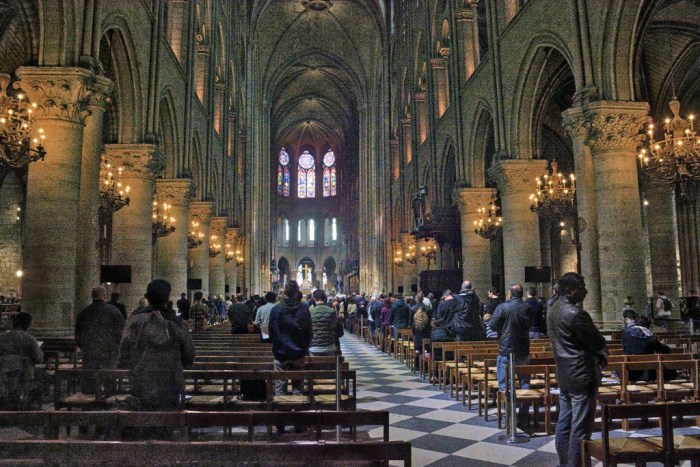
Making the most of your time at Notre Dame Cathedral requires careful planning and an understanding of the site’s layout. This section offers practical advice to help you navigate the cathedral, avoid potential pitfalls, and ensure a truly memorable experience. From pre-trip planning to post-visit reflection, these tips will enhance your journey.To truly appreciate the grandeur and history of Notre Dame, preparation is key.
Knowing what to expect and how to best utilize your time will maximize your enjoyment. This guide will provide insights into navigating the site effectively and understanding its historical significance.
Planning Ahead for a Smooth Visit
Effective planning minimizes potential issues and ensures a positive experience. Researching opening hours, ticket prices, and any special events or exhibitions in advance will prevent surprises and save time. Consider purchasing tickets online in advance to skip the potentially long queues at the entrance. Checking the weather forecast and packing accordingly is also essential, especially during the colder or wetter months.
This will prevent discomfort and allow you to fully immerse yourself in the experience.
Navigating the Cathedral and Finding Specific Areas
Notre Dame’s intricate layout can be overwhelming. Knowing how to navigate the site and locate specific areas of interest can significantly enhance your experience. Use the provided floor plans and maps to understand the cathedral’s structure and identify areas like the rose windows, the choir, or the crypt. Employing these visual aids will allow you to efficiently explore the different sections.
Staff members or volunteers at the information desk can provide additional guidance and directions if needed.
Recommended Reading Materials
To deepen your understanding and appreciation of Notre Dame, consider exploring relevant literature. Books on the history of Gothic architecture, the life of Victor Hugo, or the restoration process provide invaluable context and insights. For example, “The Hunchback of Notre Dame” by Victor Hugo, though a fictional account, offers a glimpse into the societal and historical context surrounding the cathedral during its time.
Articles or essays from reputable historical journals or academic publications are also great resources for in-depth analysis.
Photo Opportunities within and around the Cathedral
Capturing the beauty of Notre Dame requires strategic planning. The cathedral’s architecture, especially the intricate details of the gargoyles, sculptures, and stained-glass windows, provides ample opportunities for stunning photography. Early morning or late afternoon light often casts beautiful shadows and highlights architectural features, creating a dramatic effect. The surrounding Île de la Cité, with its historic bridges and landmarks, offers unique photographic opportunities for capturing the cathedral’s context within its urban environment.
Consider capturing the exterior of the cathedral at different angles to showcase its different facades.
Final Review
In conclusion, this guide to Notre Dame Paris provides a comprehensive overview of this historical landmark. From its architectural splendor to its cultural significance, Notre Dame offers a captivating journey through time. Whether you’re a history enthusiast, an architecture aficionado, or simply seeking a unique Parisian experience, this guide will equip you with the knowledge and insights needed to make the most of your visit.
We hope you’ll be inspired to visit this extraordinary place!
